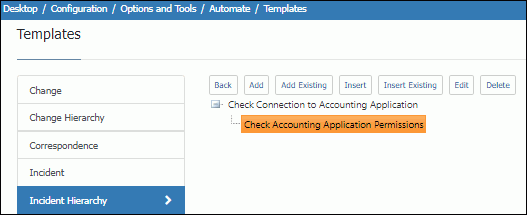Like incident templates, incident hierarchy templates initially populate fields in Incident records. Use hierarchy templates to track and manage issues, incidents, and service requests that have multiple activities. An incident is an unplanned interruption or reduction in quality of an IT service, or a failure of an asset (called a configuration item in ITIL); you can use a template as an incident model that predefines steps to handle a process.
Existing incident functionality such as routing, and followup dates apply to incidents created from hierarchy templates. However, the auto-close option cannot be set on an incident hierarchy template.
Hierarchy templates are especially useful for accountability purposes if there is more than one person involved; for example, you could create a hierarchy template for checking an application connection with someone in IT as the default assignee, and create a template for checking permissions with someone in Accounting as the default assignee.

In the example above, when the Check Connection to Accounting Application template is selected in the Incident screen, an incident is created from the Check Connection to Accounting Application template as well as the Check Accounting Application Permissions template.
Notifications regarding hierarchy events can be configured via incident rules; for example, you can send a notification to the assignee of the top (root) level incident or to the assignees of lower level incidents.
Creating a Top Level Incident Hierarchy Template
Creating a Lower Level Incident Hierarchy Template
Adding a Third Level Incident Hierarchy Template
Defining Dependencies on Other Templates in a Hierarchy
Building an Incident Workflow Hierarchy